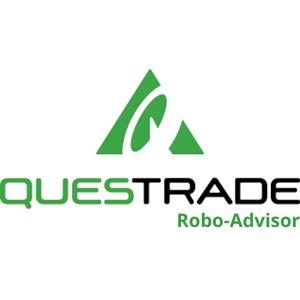Robo-advisors are becoming increasingly popular among Canadian investors seeking low-cost and hands-off ways to invest.
There are plenty of robo-advisors available in Canada, and picking out the best can be challenging. Each platform offers unique qualities and features that set it apart.
I have used and reviewed the best robo-advisors in Canada, and the number of platforms keeps increasing. Wealthsimple and Wealthbar (now CI Direct Investing) are two of the oldest robo-advisors. So, it is only natural to compare the two and wonder which one is better.
I compared the following categories for Wealthsimple vs. CI Investing below:
- Accounts Offered
- Financial Advisor Support
- Portfolios Offered
- Cost
My Wealthsimple vs. WealthBar comparison will cover all the necessary bases to help you understand which one of these Canadian robo-advisors would be the best tool for you.

About Wealthsimple

Wealthsimple Invest is Wealthsimple’s primary product that focuses on keeping investing simple for Canadians, as its name suggests. Wealthsimple is an online investment management company launched in 2014, with its robo-advisor as the core offering to investors seeking a low-cost and hands-off investing solution.
Power Corporation of Canada is Wealthsimple’s majority owner, and it is a massive company that owns multiple financial assets throughout the country. Wealthsimple is my pick for the top robo-advisor in Canada that offers you access to human financial advisors, broad investment selection, automatic tax-loss harvesting for premium clients, and a sleek and user-friendly platform.
Headquartered in Toronto, it has become one of the leading robo-advisors worldwide. It boasts $8.4 billion in assets under management (AUM) from over 1.5 million users. It has also been recognized as the Best Financial Services Website by The Webby Awards and one of the top 100 global financial technology companies.
Pros
- A broad product line
- Completely commission-free trades
- High-interest savings accounts
- An easy application process
- Many service options
Cons
- Portfolio fees are a little too high
- Limited personal finance tools
About Wealthbar (Now CI Direct Investing)

WealthBar (now CI Direct Investing) boasts a reputation of being the first robo-advisor in Canada. The Vancouver-based robo-advisor was launched in 2014 by power couple Tea and Chris Nicola.
The co-founders and husband-wife duo had prior experience in the financial sector. Tea worked as a financial advisor, and Chris began working for his father’s wealth management company.
The co-founders founded the robo-advisor with the support of Nicola Wealth Management’s owner, John Nicola. CI Financial Corp. announced in January 2019 that it had successfully acquired WealthBar, and the company rebranded WealthBar to “CI Direct Investing” after taking over.
CI Direct Investing offers many of the qualities necessary to make it comparable to other robo-advisor platforms in Canada. It also operates as a platform for you to purchase insurance policies and adds the benefit of exceptional financial planning tools for each client.
Pros
- Access to highly diversified ETF portfolios
- Free financial advice
- Automatic rebalancing
- Dedicated financial planner
- Low-cost ETF portfolios
Cons
- Charges higher fees than competitors
- Minimum $1,000 deposit to open an account
Wealthsimple vs. CI Direct Investing 2024– Features & Benefits

This section will discuss the features and benefits that both robo-advisors offer. Additionally, it will give you an overview of the products to help you determine which platform might work better to help you achieve your investment goals.
Wealthsimple vs. CI Direct Investing – How Much Do They Cost?
This section will discuss the expenses you can expect with both robo-advisors. Robo-advisors have been designed to provide a lower-cost solution than traditional investing methods to Canadian investors. However, the costs of using each of these two platforms are different.
Wealthsimple Fees
Wealthsimple follows a tiered fee structure for its customers, charging an annual fee based on your account balance with the robo-advisor. Here is what the annual fees look like with Wealthsimple:
| Portfolio Deposits | Fee |
| Under $99,999 | 0.50% |
| Above $100,000 | 0.40% |
Wealthsimple MER
On top of the fees that Wealthsimple charges, there are also fees charged by the investment fund managers of the portfolio. These fees are called the management expense ratio (MER). The ETF providers charge MER fees, and this fee applies to all robo-advisors.
Here is a look at the average MER for each of the different ETF portfolios available with Wealthsimple.
| Investment Portfolio | Average MER |
| Conservative ETF Portfolio | 0.16% |
| Balanced ETF Portfolio | 0.16% |
| Growth ETF Portfolio | 0.22% |
CI Direct Investing Fees
CI uses a multi-tiered pricing system that charges fees based on your portfolio value with the robo-advisor. The annual fees you pay include transaction and administrative costs. It also covers the fees for all its financial planning services. If you use a tax-deductible account with CI Direct Investing, you can deduct the fees it charges on your tax returns.
| Portfolio Deposits | Fee |
| Between $5,000 and $150,000 | 0.60% per year |
| Between $150,001 and $500,000 | 0.40% per year |
| Above $500,000 | 0.35% per year |
CI Direct Investing MER
Here is a look at the average MER for each of the different ETF portfolios available
| Investment Portfolio | Average MER |
| Aggressive ETF Portfolio | 0.25% |
| Growth ETF Portfolio | 0.26% |
| Balanced ETF Portfolio | 0.26% |
| Conservative ETF Portfolio | 0.19% |
| Safety ETF Portfolio | 0.16% |
| Aggressive Private ETF Portfolio | 1.40% |
| Balanced Private ETF Portfolio | 1.55% |
| Safety Private Portfolio | 1.00% |
CI Direct Investing offers lower fees for customers with deposits of $500,001 and above. Wealthsimple also offers lower MERs than CI Direct Investing for its investment portfolios. The MER for CI’s private portfolios can go as high as 1.55%, making it far costlier than Wealthsimple.
Wealthsimple is the clear winner here for cost. It follows a two-tiered pricing structure, thus charging you a lower amount than CI. Up until deposits of $500,000, Wealthsimple charges lower annual fees.
Wealthsimple vs. CI – Accounts Offered
Wealthsimple and CI Direct Investing offer you several account types that you can open with the platforms:
Accounts Offered By Wealthsimple
- Registered Retirement Savings Plan (RRSP)
- Tax-Free Savings Account (TFSA)
- Registered Education Savings Plan (RESP)
- Joint or personal Non-Registered Accounts
- Registered Retirement Income Fund (RRIF)
- Locked-In Retirement Account (LIRA)
- Corporate Accounts
- Spousal RRSP
Accounts Offered By CI
- Registered Retirement Savings Plan (RRSP)
- Tax-Free Savings Account (TFSA)
- Registered Education Savings Plan (RESP), including for Quebec residents
- Non-registered Accounts
- Registered Retirement Income Fund (RRIF)
- Locked-In Retirement Account (LIRA)
- Corporate Accounts
- Formal In-Trust accounts
- Informal In-Trust accounts
- Charitable Organization Investment Accounts
- Group TFSAs and RRSPs (offered to business owners for their employees)
- Life Income Fund (LIF)
CI Direct Investing is the winner in this category, and edges past Wealthsimple by offering more account types.
Wealthsimple vs. CI – Financial Advisor Support
As robo-advisors, both platforms are designed to make investing more convenient for you and offer financial advisor support to their clients.
Financial Advisor Support Offered By Wealthsimple
Wealthsimple is a massive robo-advisor with a broad user base. Unfortunately, that comes at the cost of a less personalized feel while using the platform.
The robo-advisor offers excellent financial support to Wealthsimple Black customers by arranging financial planning sessions to discuss your goals with a portfolio manager. You need to have an account deposit of over $100,000 to become a Wealthsimple Black customer.
On the other hand, you can become a Wealthsimple Generation customer if you have over $500,000 in deposits with the platform. As a Wealthsimple Generation client, you can access a dedicated financial advisor team to will help you with your financial planning.
You can contact Wealthsimple via email if you need financial support, and you aren’t a Wealthsimple Black or Wealthsimple Generation customer.
Financial Advisor Support Offered By CI
CI Direct Investing does not boast as many clients as Wealthsimple, which can be seen as an advantage for you if you seek excellent financial advisor support. CI Direct Investing has a dedicated team of financial advisors available for all its customers. You can contact them via the online chat option available with the robo-advisor.
Unlike Wealthsimple, CI Direct Investing lets you access ongoing comprehensive reviews for free from a dedicated financial advisor to help you stay in line with your financial goals. It also offers additional services like insurance needs analysis, tax optimization advice, estate planning, and corporate tax planning.
CI Direct Investing is the winner when it comes to financial advice, and offers more comprehensive services to its customers than Wealthsimple.
Wealthsimple vs. CI – Portfolios Offered
Wealthsimple and CI Direct Investing offer several investment portfolios that you can choose to align with your financial goals, risk tolerance, and investment objectives.
Portfolios Offered By Wealthsimple
As its name suggests, Wealthsimple focuses on keeping investing simple for you. Instead of providing you with a wide range of customized portfolios, it offers three primary portfolios that combined eight ETFs.
Here are the three Wealthsimple portfolios you can use:
- Growth Portfolio: The growth portfolio is Wealthsimple’s version of an aggressive portfolio designed to grow investor wealth. The portfolio is for investors with a medium to high risk tolerance. Wealthsimple’s growth portfolio typically offers a 75%-90% exposure to equity securities and a 10%-25% exposure to fixed-income securities.
- Balanced Portfolio: The balanced portfolio is designed for investors with medium tolerance to risk. Wealthsimple’s balanced portfolio typically offers 50% exposure to fixed-income securities and 50% to equity securities.
- Conservative Portfolio: The conservative portfolio is for investors who want to minimize the risk to their capital. Wealthsimple’s conservative portfolio typically offers only 35% exposure to equity securities and 65% to fixed-income securities.
Portfolios Offered By CI
CI Direct Investing offers you a wide range of customized portfolios that align with different risk-tolerance levels and investment objectives. It also offers private portfolios that let you access private pooled funds managed by Nicola Wealth Management.
Here are the eight CI Direct Investment portfolios you can use with the robo-advisor:
- Aggressive ETF Portfolio: CI Direct Investing’s Aggressive ETF portfolio is suitable for you if you have a medium to high risk tolerance, have a long-term investment horizon, and are comfortable with investing most of your capital in equity securities and real estate.
- Growth ETF Portfolio: CI Direct Investing’s Growth ETF portfolio is suitable for you if you have a medium risk tolerance, have an intermediate to long-term investment horizon, and are comfortable with most of your portfolio consisting of equity securities, real estate, and alternatives.
- Balanced ETF Portfolio: CI Direct Investing’s Balanced ETF portfolio is suitable for you if you have a medium risk tolerance, have an intermediate investment horizon, and prefer a diversified portfolio that offers a good mixture of equity securities, fixed-income assets, real estate, and alternatives.
- Conservative ETF Portfolio: CI Direct Investing’s Conservative ETF portfolio is designed for investors with a short or intermediate investment horizon. You might prefer it if you prefer most of your portfolio consisting of fixed-income assets and equity securities.
- Safety ETF Portfolio: CI Direct Investing’s Balanced ETF portfolio is ideal for you if you have a low risk tolerance and do not mind having your portfolio primarily consist of fixed-income assets and securities with low risk and low returns.
- Aggressive Private Portfolio
- Balanced Private Portfolio
- Safety Private Portfolio
Both platforms offer Socially Responsible Investing (SRI) and Halal investing options to Canadian investors who want to make investment decisions aligning with their moral values.
CI Direct Investing wins over Wealthsimple for selection of portfolios. The robo-advisor offers additional customized portfolios through its three Private Portfolios and more Standard Portfolios than Wealthsimple. Its private portfolios are also typically available to investors with over $1 million in deposit.
Wealthsimple vs. CI Direct Investing – The Verdict

Wealthsimple is my top pick despite CI Direct Investing offering several premium features that make it more than a simple robo-advisor. Here is a quick look at both robo-advisors and when it would be ideal to use them.
Use Wealthsimple If:
- You seek a low-fee structure when starting to invest.
- You seek expert financial advice with a higher investment capital of $100,000 for Wealthsimple Black and $500,000 for Wealthsimple Generation.
- You seek more straightforward options when choosing your preferred ETF portfolios.
You can check out Wealthsimple by clicking here.
Use CI Direct Investing If:
- You seek free expert financial advice.
- You plan to invest over $500,000 in your preferred portfolio.
- You want access to premium private portfolios and don’t mind the higher costs.
You can check out CI Direct Investing by clicking here.
WealthBar (now CI Direct Investing) and Wealthsimple were the innovators for Canada’s robo-advisor industry. Both platforms offer a low-cost alternative for hands-off investing solutions than traditional financial institutions.
Wealthsimple is the winner for me in large part due to its substantially lower fees and MERs. However, CI Direct Investing offers more comprehensive services that could be useful for you.
The final choice between these two depends on your investment goals and which platform offers features that you find more attractive.





